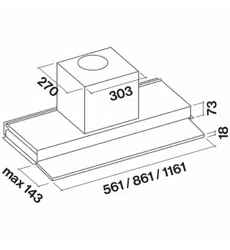Loading ...
Loading ...
Loading ...

17
ENGLISH
INSTALLATION
only intended for qualied personnel
Before installing the hood, carefully read the chapter 'SAFETY
INSTRUCTIONS AND WARNINGS'.
TECHNICAL FEATURES
The technical specications are exhibited on the labels located inside the hood.
POSITIONING
The minimum distance between the highest part of the cooking equip-
ment and the lowest part of the hood is indicated in the installation in-
structions.
Generally, when the hood is placed over gas cookers, the distance must be
at least 65 cm (25.6''). However, according to an interpretation of standard
EN60335-2-31 dated 11-07-2002 of TC61 (sub-clause 7.12.1 meeting 15 agenda
item 10.11), the minimum distance between the cooker and lower part of the
hood can be reduced to the quota reported in the installation instructions.
Should the instructions for the gas cooker specify a greater distance, this must
be taken into consideration.
Do not install the hood outdoors and do not expose it to outdoor environment
(rain, wind, etc.).
ELECTRICAL CONNECTION
(only intended for qualied personnel)
Disconnect the equipment from electrical mains power supply be-
fore carrying out any operations on the hood.
Ensure that the wires inside the hood are not disconnected or cut:
in the event of damage, contact your nearest Servicing Department.
Refer to qualied personnel for electrical connections.
Connection must be carried out in compliance with the provisions of law
in force.
Before connecting the hood to the electrical mains power supply, check that:
• voltage supply corresponds with what is reported on the data plate located
inside the hood;
• the electrical system is compliant and can withstand the load (see the techni-
cal specications located inside the hood);
• the power supply plug and cable do not come into contact with tempera-
tures exceeding 70 °C;
• the power supply system is eectively and properly connected to earth in
compliance with regulations in force;
• the socket used to connect the hood is within reach.
In case of:
• devices tted with cables without a plug: the type of plug to use is a ''stand-
ardised'' one. The wires must be connected as follows: yellow-green for earth-
ing, blue for neutral and brown for the phase. The plug must be connected to
an adequate safety socket.
• xed equipment not provided with a power supply cable and plug, or any
other device that ensures disconnection from the electrical mains, with an
opening gap of the contacts that enables total disconnection in overvoltage
category III conditions.
Said disconnection devices must be provided in the mains power supply in
compliance with installation regulations.
The yellow/green earth cable must not be cut o by the switch.
The Manufacturer declines all responsibility for failure to comply with the safety
regulations.
FUMES DISCHARGE
EXTERNAL EXHAUST HOOD SUCTION
In this version the fumes and vapours are discharged outside
through the exhaust pipe.
To this end, the hood outlet tting must be connected via a
pipe, to an external output.
The outlet pipe must have:
• a diameter not less than that of the hood tting.
• a slight slope downwards (drop) in the horizontal sections to prevent conden-
sation from owing back into the motor.
• the minimum required number of bends.
• the minimum required length to avoid vibrations and reduce the suction per-
formance of the hood.
You are required to insulate the pipes if it passes through cold environments.
In the presence of motors with 800m3/h or higher, a check valve is present to
prevent external air owing back.
Deviation for Germany:
when the kitchen hood is used at the same time as appliances that are powered by
energy other than electricity, the negative pressure in the room must not exceed 4 Pa
(4 x 10-5 bar).
HOOD WITH INTERNAL RECIRCULATION FILTERING
In this model, the air passes through the charcoal lters to be
puried and recycled in the environment.
Ensure that the active carbon lters are assembled into the
hood, if not, install them as indicated in the assembly instruc-
tions.
In this version the check valve must not be assembled: remove it if it is
on the air outlet tting of the motor.
ASSEMBLY INSTRUCTIONS
only intended for personnel qualied
The hood can be installed in various congurations.
The generic assembly steps apply to all installations; for each case,
follow the specic steps provided for the required installation.
OPERATION
WHEN TO TURN ON THE HOOD?
Switch on the hood at least one minute before starting to cook to direct fumes
and vapours towards the suction surface.
After cooking, leave the hood operating until complete extraction of all vapours
and odours. By means of the Timer function, it is possible to set auto switch-o
function which will allow the hood to turn o automatically after 15 minutes of
operation.
WHICH SPEED IS TO BE SELECTED?
1st speed: maintains the circulation of clean air with low electricity consumption.
2nd speed: normal conditions of use.
3rd speed: presence of strong odours and vapours.
4th speed: rapid disposal of odours and vapours.
WHEN SHOULD THE FILTERS BE WASHED OR REPLACED?
The metal lters must be cleaned every 30 hours of operation.
The active carbon lters must be replaced every 3-4 months, depending on the
use of the hood.
For further details see the “MAINTENANCE” chap.
ELECTRONIC PUSHBUTTON PANEL
Motor ON/OFF
At start-up, the speed is 1.
Increase speed from 1 to 4
Speed 4 is only active for a few
minutes, then speed 3 activates.
The speeds are indicated by the
LEDs on the keys:
Speed 1
Speed 2
Speed 3
Speed 4
("+" LED ashing)
Reduce speed from 4 to 1
Loading ...
Loading ...
Loading ...
